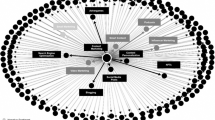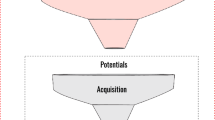Abstract
Microblogging applications such as Twitter are experiencing tremendous success. Microblog users utilize hashtags to categorize posted messages which aim at bringing order to the myriads of microblog messages. However, the percentage of messages incorporating hashtags is small and the used hashtags are very heterogeneous as hashtags may be chosen freely and may consist of any arbitrary combination of characters. This heterogeneity and the lack of use of hashtags lead to significant drawbacks in regards to the search functionality as messages are not categorized in a homogeneous way. In this paper, we present an approach for the recommendation of hashtags suitable for the message the user currently enters which aims at creating a more homogeneous set of hashtags. Furthermore, we present a detailed study on how the similarity measures used for the computation of recommendations influence the final set of recommended hashtags.






Similar content being viewed by others
Notes
References
Adomavicius G, Tuzhilin A (2005) Toward the next generation of recommender systems: a survey of the state-of-the-art and possible extensions. IEEE Trans Knowl Data Eng 17(6):734–749
Ames M, Naaman M (2007) Why we tag: motivations for annotation in mobile and online media. In: Proceedings of the SIGCHI conference on Human factors in computing systems, CHI ’07. ACM, New York, pp 971–980
Baeza-Yates R, Ribeiro-Neto B (1999) Modern information retrieval. Addison-Wesley, New York
Balabanović M, Shoham Y (1997) Fab: content-based, collaborative recommendation. Commun ACM 40:66–72
Bollen D, Knijnenburg BP, Willemsen MC, Graus M (2010) Understanding choice overload in recommender systems. In: Proceedings of the fourth ACM conference on Recommender systems, RecSys ’10. ACM, New York, pp 63–70
Boyd D, Golder S, Lotan G (1899) Tweet, tweet, retweet: conversational aspects of retweeting on twitter. In: HICSS, IEEE Computer Society, pp 1–10
Chen J, Nairn R, Nelson L, Bernstein M, Chi E (2010) Short and tweet: experiments on recommending content from information streams. In: Proceedings of the 28th international conference on Human factors in computing systems. ACM, New York, pp 1185–1194
Cremonesi P, Turrin R, Lentini E, Matteucci M (2008) An evaluation methodology for collaborative recommender systems. In: IEEE International Conference on Automated solutions for Cross Media Content and Multi-channel Distribution, 2008. AXMEDIS’08, pp 224–231
Dice L (1945) Measures of the amount of ecologic association between species. Ecol Freshw Fish 26(3):297–302
Gabrilovich E, Markovitch S (2007) Computing semantic relatedness using wikipedia-based explicit semantic analysis. In: Proceedings of the 20th international joint conference on artificial intelligence, vol 6. Morgan Kaufmann Publishers Inc., pp 1606–1611
Garg N, Weber I (2008) Personalized, interactive tag recommendation for flickr. In: Proceedings of the 2008 ACM conference on Recommender systems, RecSys ’08. ACM, New York, pp 67–74
Gassler W, Zangerle E, Specht G (2011) The snoopy concept: fighting heterogeneity in semistructured and collaborative information systems by using recommendations. In: The 2011 International Conference on Collaboration Technologies and Systems (CTS 2011), Philadelphia
Hannon J, Bennett M, Smyth B (2010) Recommending twitter users to follow using content and collaborative filtering approaches. In: RecSys ’10: Proceedings of the fourth ACM conference on Recommender systems. ACM, New York, pp 199–206
Honeycutt C, Herring SC (2009) Beyond microblogging: conversation and collaboration via Twitter. In: HICSS, IEEE Computer Society, pp 1–10
Huberman B, Romero D, Wu F (2009) Social networks that matter: Twitter under the microscope. First Monday 14(1):8
Jaccard P (1901) Étude Comparative de la Distribution Florale dans une Portion des Alpes et des Jura. Bulletin del la Société Vaudoise des Sciences Naturelles, 37:547–579
Jaeschke R, Marinho L, Hotho A, Schmidt-Thieme L, Stumme G (2007) Tag recommendations in Folksonomies. In: Kok J, Koronacki J, Lopez de Mantaras R, Matwin S, Mladenic D, Skowron A (eds) Knowledge discovery in databases: PKDD 2007, vol 4702 of Lecture Notes in Computer Science. Springer, Berlin, pp 506–514
Java A, Song X, Finin T, Tseng B (2007) Why we twitter: understanding microblogging usage and communities. In: Proceedings of the 9th WebKDD and 1st SNA-KDD 2007 workshop on Web mining and social network analysis. ACM, New York, pp 56–65
Jones K (1972) A statistical interpretation of term specificity and its application in retrieval. J Documentation 28(1):11–21
Krishnamurthy B, Gill P, Arlitt M (2008) A few chirps about twitter. In: Proceedings of the first workshop on Online social networks. ACM, New York, pp 19–24
Kwak H, Lee C, Park H, Moon S (2010) What is Twitter, a social network or a news media? In: Proceedings of the 19th international conference on World wide web. ACM, New York, pp 591–600
Levenshtein V (1965) Binary codes with correction for deletions and insertions of the symbol 1. Problemy Peredachi Informatsii 1(1):12–25
Levenshtein V (1966) Binary codes capable of correcting deletions, insertions, and reversals. Soviet Phys Doklady 10:707–710
Lipczak M, Milios E (2010) Learning in efficient tag recommendation. In: Proceedings of the fourth ACM conference on Recommender systems, RecSys ’10. ACM, New York, pp 167–174
Manning CD, Raghavan P, Schütze H (2008) Introduction to information retrieval. Cambridge University Press, Cambridge
Marlow C, Naaman M, Boyd D, Davis M (2006) HT06, tagging paper, taxonomy, Flickr, academic article, to read. In: Proceedings of the seventeenth conference on Hypertext and hypermedia, HT ’06. ACM, New York, pp 31–40
Mihalcea R, Corley C, Strapparava C (2006) Corpus-based and knowledge-based measures of text semantic similarity. In: Proceedings of the national conference on artificial intelligence, vol 21. AAAI Press, Menlo Park; MIT Press, London
Miller G (1956) The magical number seven, plus or minus two: some limits on our capacity for processing information. Psychol Rev 63(2):81
Nishida K, Banno K, Fujimura K, Hoshide T (2011) Tweet classification by data compression. In: Proceedings of the 2011 international workshop on DETecting and Exploiting Cultural diversiTy on the social web. ACM, New York, pp 29–34
Pazzani M, Billsus D (2007) Content-based recommendation systems. In: Brusilovsky P, Kobsa A, Nejdl W (eds) The adaptive web, vol 4321 of Lecture Notes in Computer Science. Springer, Berlin, pp 325–341
Phelan O, McCarthy K, Smyth B (2009) Using twitter to recommend real-time topical news. In: Proceedings of the third ACM conference on recommender systems. ACM, New York, pp 385–388
Rae A, Sigurbjörnsson B, van Zwol R (2010) Improving tag recommendation using social networks. In: Adaptivity, Personalization and Fusion of Heterogeneous Information, RIAO ’10. Le Centre de Hautes Etudes Internationales d’Informatique Documentaire, Paris, pp 92–99
Resnick P, Varian H (1997) Recommender systems. Commun ACM 40(3):58
Robertson SE, Walker S, Jones S, Hancock-Beaulieu M, Gatford M (1994) Okapi at TREC-3. In: Proceedings of the Text Retrieval Conference (TREC). National Institute of Standards and Technology, Gaithersburg, pp 109–126
Romero DM, Meeder B, Kleinberg JM (2011) Differences in the mechanics of information diffusion across topics: idioms, political hashtags, and complex contagion on twitter. In: Srinivasan S, Ramamritham K, Kumar A, Ravindra MP, Bertino E, Kumar R (eds) WWW. ACM, New York, pp 695–704
Salton G, Buckley C (1988) Term-weighting approaches in automatic text retrieval. Inf Process Manag 24(5):513–523
Schedl M (2010) On the use of microblogging posts for similarity estimation and artist labeling. In: Downie JS, Veltkamp RC (eds) ISMIR, International Society for Music Information Retrieval, pp 447–452
Schedl M (2012) # nowplaying madonna: a large-scale evaluation on estimating similarities between music artists and between movies from microblogs. Inf Retr 1–35
Sebastiani F (2002) Machine learning in automated text categorization. ACM Comput Surv (CSUR) 34(1):1–47
Sen S, Vig J, Riedl J (2009) Tagommenders: connecting users to items through tags. In: Proceedings of the 18th international conference on world wide web, WWW ’09. ACM, New York, pp 671–680
Sigurbjörnsson B, Van Zwol R (2008) Flickr tag recommendation based on collective knowledge. In: Proceeding of the 17th international conference on world wide web. ACM, New York, pp 327–336
Tatu M, Srikanth M, D’Silva T (2008) RSDC’08: Tag recommendations using bookmark content. In: Workshop at 18th European Conference on Machine Learning (ECML’08)/11th European Conference on Principles and Practice of Knowledge Discovery in Databases PKDD08
Ye S, Wu S (2010) Measuring Message Propagation and Social Influence on Twitter. com. In: Proceedings of Second International Conference, Socinfo 2010, on Social Informatics, Laxenburg. Springer, New York, pp 216–231
Zangerle E, Gassler W, Specht G (2011) Using tag recommendations to homogenize folksonomies in microblogging environments. In: Bolc L, Makowski M, Wierzbicki A (eds) Proceedings of Third International Conference, SocInfo 2011, on Social Informatics, Singapore, vol 6430 of Lecture Notes in Computer Science. Springer, Berlin, pp 1–18
Author information
Authors and Affiliations
Corresponding author
Rights and permissions
About this article
Cite this article
Zangerle, E., Gassler, W. & Specht, G. On the impact of text similarity functions on hashtag recommendations in microblogging environments. Soc. Netw. Anal. Min. 3, 889–898 (2013). https://doi.org/10.1007/s13278-013-0108-x
Received:
Revised:
Accepted:
Published:
Issue Date:
DOI: https://doi.org/10.1007/s13278-013-0108-x




